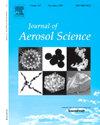利用低成本颗粒物传感器调查气体颗粒物分离过程中在线颗粒物浓度测量的潜力
IF 3.9
3区 环境科学与生态学
Q2 ENGINEERING, CHEMICAL
引用次数: 0
摘要
除了昂贵的实验室颗粒物测量设备外,用于环境空气质量测量的低成本颗粒物传感器也可用于检测气体净化设备中的可吸入颗粒物。在气体-颗粒分离过程中,能够以较高的时间分辨率从空间上解析颗粒数量浓度的实际水平,这对于过程监测和控制具有重要价值。当设备中的颗粒浓度暂时或永久超过传感器的测量上限时,低成本颗粒物传感器测量数据的定量可靠性仍不确定。本研究探讨了低成本颗粒物传感器在气体颗粒分离过程中进行在线颗粒物浓度测量的潜力。低成本颗粒物传感器的测量性能最初是在粉尘室的理想条件下进行检测的。这样做是为了量化低成本颗粒物传感器与最先进的精密实验室高成本传感器之间的偏差。随后,在对两种传感器各自的测量性能进行量化后,将其安装在湿式分离器测试设备上。根据测量条件的不同,低成本颗粒物传感器能够测量超过其规定限值(最高可达 ≈6.1×104cm-3)的颗粒数浓度。通过应用从初始定量测量中获得的三次多项式修正函数,低成本颗粒物传感器能够再现高成本传感器测量的颗粒数浓度。此外,低成本颗粒物传感器还能再现颗粒数浓度的短期波动。本文章由计算机程序翻译,如有差异,请以英文原文为准。

Investigation of the potential of in-line particle concentration measurements in gas particle separation processes by using low-cost particulate matter sensors
In addition to the costly laboratory-based particle measurement devices, low-cost particulate matter sensors for ambient air quality measurements can also be employed for the detection of PM in gas cleaning devices. The ability to spatially resolve the actual level of particle number concentration with high temporal resolution within a gas-particle separation process is of significant value for process monitoring and control. The quantitative reliability of the measurement data from low-cost particulate matter sensors remains uncertain when the particle concentrations in the apparatus exceed the upper measurement limit of the sensors, whether temporarily or permanently. This study examines the potential of low-cost particulate matter sensors for in-line particle concentration measurements in gas-particle separation processes. The measurement performance of the low-cost particulate matter sensors is initially examined under idealised conditions in a dust chamber. This is done in order to quantify the deviations of the low-cost particulate matter sensors in comparison to a state-of-the-art precision laboratory high-cost sensor. Subsequently, both sensor types are installed at a wet separator test facility, following the quantification of their respective measurement performances. The low-cost particulate matter sensors are capable of measuring particle number concentration above their specified limit (up to ), depending on the measurement conditions. By applying a 3rd polynomial correction function, obtained from the initial quantification measurement, the low-cost particulate matter sensors are able to reproduce the particle number concentration measured by the high-cost sensor. Furthermore, the low-cost particulate matter sensors are capable of reproducing short-term fluctuations in the particle number concentration.
求助全文
通过发布文献求助,成功后即可免费获取论文全文。
去求助
来源期刊

Journal of Aerosol Science
环境科学-工程:化工
CiteScore
8.80
自引率
8.90%
发文量
127
审稿时长
35 days
期刊介绍:
Founded in 1970, the Journal of Aerosol Science considers itself the prime vehicle for the publication of original work as well as reviews related to fundamental and applied aerosol research, as well as aerosol instrumentation. Its content is directed at scientists working in engineering disciplines, as well as physics, chemistry, and environmental sciences.
The editors welcome submissions of papers describing recent experimental, numerical, and theoretical research related to the following topics:
1. Fundamental Aerosol Science.
2. Applied Aerosol Science.
3. Instrumentation & Measurement Methods.
 求助内容:
求助内容: 应助结果提醒方式:
应助结果提醒方式:


